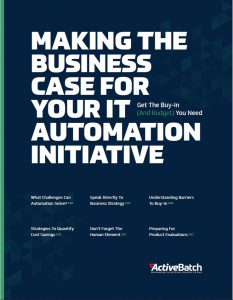In 2018, Forrester predicted that business process automation could cut operating costs up to 90 percent. It’s now 2020. What impact does business process automation have on business today?
What Is Business Process Automation?
Business process automation (BPA) focuses on automating day-to-day IT processes and business functions to maximize efficiency and ensure smooth operations. More specifically, business process automation looks to automate repetitive tasks that otherwise require manual intervention such as employee onboarding, file transfers, generating and distributing reports, approval processes, and more.
In the 1980s and ‘90s, when businesses began to computerize their processes and automate basic, repetitive tasks, the trend toward standardizing tasks and optimizing those processes evolved into business process management (BPM). BPM is the practice of evaluating, optimizing, and standardizing business processes to align with company-wide objectives. Those processes have proliferated over the last 20 years, creating complex, high-volume environments that are impossible to manage without automation, hence the development of business process automation.
What Business Process Automation Is Not
Robotic process automation (RPA) is an area of automation that’s often compared to BPA since both emphasize process improvement through removing human interactions from repeatable tasks. However, RPA automates pre-defined, rules-based tasks via user-interfaces (UIs) while BPA integrates programmatically and can therefore provide more resilient and dynamic automation, especially with regards to complex, end-to-end processes.
Why Is Business Process Automation Important?
Businesses increasingly rely on digital systems to manage data and access real-time information. But as workloads surge and IT becomes more complex, manually managing mission-critical processes just won’t cut it if businesses want to remain competitive.
BPA enables organizations to shift their focus from maintaining manual, tedious tasks to creating improved, orchestrated workflows that can effectively and efficiently add business value. This means developing adaptive business processes that span across environments and provide real-time insight for enterprise-wide visibility and control.
BPA software helps businesses become more efficient by managing data and dependencies across multiple tools and technologies, often without the need for scripting. This enables IT to accommodate changing business requirements quickly and reliably, which in turn results in customer satisfaction since there no delays or interruptions in services or product updates. For example, finance and healthcare industries rely on real-time data to influence decision-making and provide transparency to customers. BPA enables this through facilitating end-to-end processes that connect IT and data warehouses to critical business processes.
BPA solutions can readily integrate with disparate tools and technologies, allowing IT to monitor and control end-to-end processes throughout the enterprise. This promotes organization-wide transparency by providing monitoring and auditing for processes and systems across the enterprise. Furthermore, BPA provides transparency and peace of mind to key stakeholders as critical processes are tracked and monitored with comprehensive audit trails, real-time information, and auto-remediation workflows.
Common Tasks Automated Through BPA
- Onboarding Processes: Employee onboarding often involves a checklist of tedious administrative tasks, leaving room for manual errors and compliance risks. This places extra workload not just on the human resources team, but also IT staff. Business process automation streamlines the employee onboarding process by eliminating the need for manual interventions, saving time and resources as a result. For example, through workflow automation, organizations can automate the promotion of user accounts through directory services such as Active Directory, adding accounts to the appropriate new groups, modifying security settings, and then updating information in a database such as SQL Server.
- Document Management: Moving documents between folders and applications can be time-consuming and prone to human error. To streamline this process, most organizations automate their file transfers using batch scripts or file transfer management tools. As a result, managed file transfer (MFT) operations and MFT software is often managed separately from the larger automation environment, making day-to-day business processes more complex. Business process automation software eliminates this complexity by consolidating MFT operations into a single solution. Furthermore, BPA promotes secure data movement and file sharing between end-to-end workflows and supports secure file transfer protocols (including SFTP and FTPS).
- Data Integration: BPA enables end-to-end workflows between automation software and ERP applications such as Informatica PowerCenter, Oracle PeopleSoft, SAP BusinessObjects Data Services, or Microsoft Dynamics AX, without spending an exorbitant amount of time, costs, and resources manually scripting integrations between applications and infrastructure. More importantly, the seamless integration between applications, databases, and compute resources minimizes slack time so key data and insights can be quickly accessible.
- Back-Office Processes: Back-office functions frequently involve support from administration, help desk teams, and IT staff. BPA streamlines end-to-end workflows between commonly used back office applications and cloud-based infrastructures to quickly provide help desk teams and business users with real-time data needed to complete day-to-day operations such as invoicing, purchase orders, expense reports, approval processes, customer support, data entry, and so forth.
How BPA Fits Into An Overall Automation Strategy
Let’s face it- businesses are becoming increasingly digital and dealing with greater volumes of data than ever before. To sustain success, they need to quickly and cost-effectively adjust to changing demands. And as is the case in most organizations, IT departments have been tasked with rising to the occasion. The impact? IT departments are operating in increasingly complex environments that contain an array of heterogeneous applications, databases, and platforms. But IT need not fear. A holistic, unified approach to automation proves advantageous in the fight against complexity.
Gartner agrees, noting: “Intelligent BPM suites (iBPMS) have a solid foundation of tools for orchestrating processes and automating tasks within those processes. iBPMS consolidates integration services, decision management, process orchestration, ad hoc processes and advanced analytics into a single platform.”
Consolidating IT and business processes into a single platform enables IT to move away from siloed automation tools and limited-capability point schedulers, so that the business can develop an orchestrated automation strategy that facilitates end-to-end processes across the enterprise, providing greater visibility, insight, and innovation.

